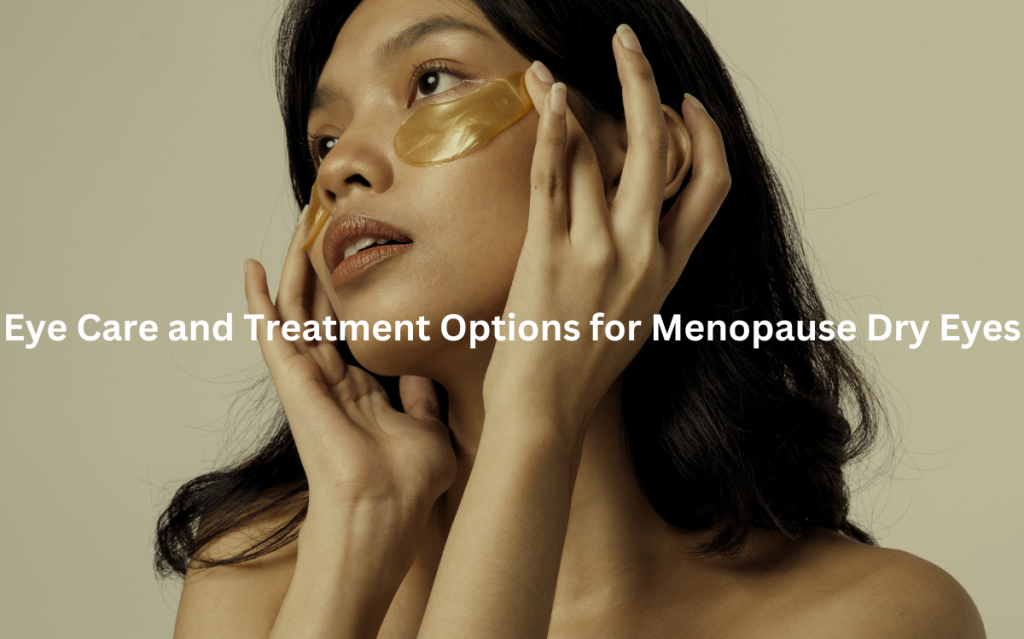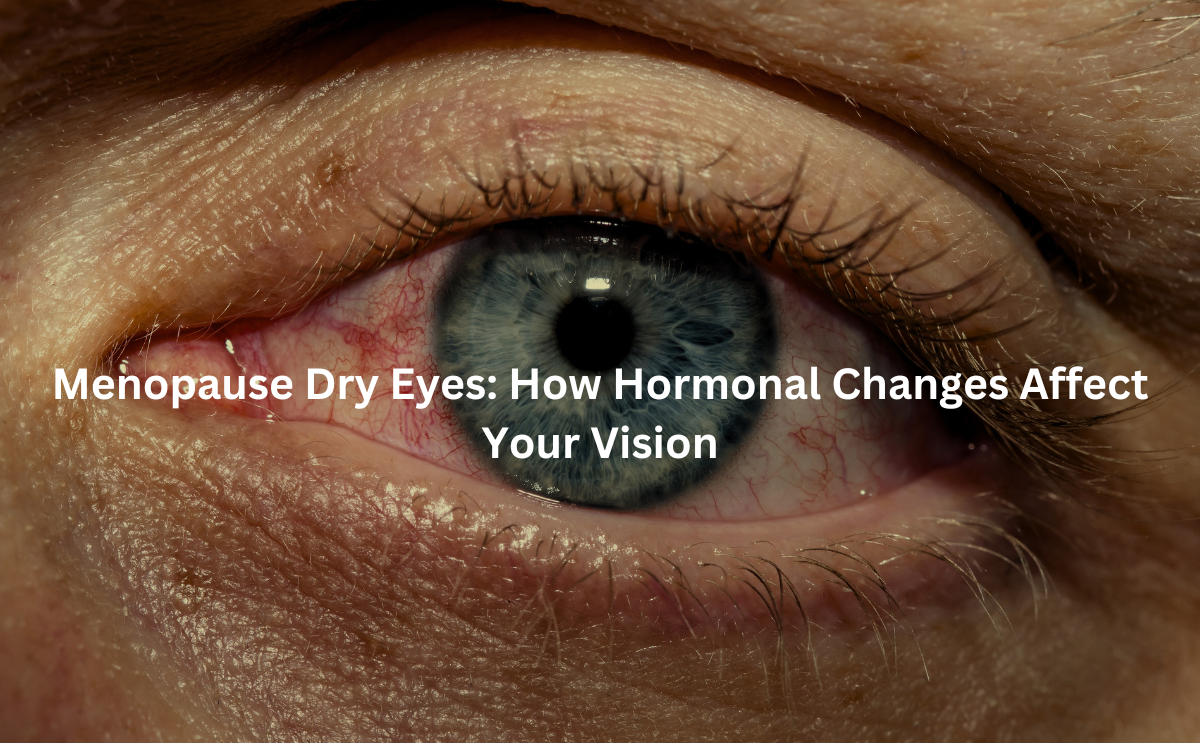Learn how menopause affects your eyes and effective solutions to ease dry eye discomfort.
Menopause brings many challenges, and dry eyes can be one of the most uncomfortable. As hormonal fluctuations, particularly a drop in estrogen, affect tear production, many women experience irritation, blurred vision, and increased sensitivity. (1)
Understanding this connection between menopause and dry eyes is essential for finding relief and restoring eye comfort.
Key Takeaways
- Hormonal changes during menopause reduce tear production, leading to dry eyes.
- Hormone Replacement Therapy (HRT) can help alleviate dry eye symptoms.
- Effective eye care, including artificial tears and lifestyle adjustments, provides relief.
Understanding Menopause and Dry Eyes
As women approach menopause, many experience a range of physical changes that affect their daily lives, but one symptom often flies under the radar: dry eyes. It’s not uncommon for women to overlook the connection between their fluctuating hormones and eye health.
But menopause significantly impacts the body’s hormonal balance, especially estrogen. Estrogen, a hormone that plays a crucial role in regulating various bodily functions, declines during menopause, affecting everything from skin elasticity to tear production.
The reduction in estrogen is directly linked to dry eyes. Estrogen helps maintain the moisture and stability of the tear film, so when levels of this hormone drop, the body’s ability to produce enough tears also diminishes.
This can lead to dryness, irritation, and discomfort—common symptoms for women navigating menopause. The hormonal changes during this time are no small thing, as they can lead to a cascade of effects on eye health.
Common Symptoms of Menopause-Related Dry Eyes
Menopause can bring about dry eyes that go beyond just feeling dry. It’s often accompanied by a gritty, burning sensation, making it hard to go through the day without constant discomfort. Many women experience a dry feeling that doesn’t seem to go away, especially in the morning or after long hours of screen use.
Other symptoms can include blurry vision and increased sensitivity to light. Even natural sunlight can feel too harsh, making outdoor activities harder to enjoy. These eye troubles don’t exist in a vacuum—hormonal changes during menopause often worsen the condition, leading to more frequent irritation and dryness.
The struggle might look like this:
- Dryness: Parched, tired eyes.
- Irritation: Gritty or burning sensations.
- Blurry vision: Difficulty focusing, especially after screen time.
- Light sensitivity: Sunlight feels overwhelming.
For many women, dry eyes become a daily challenge, disrupting everything from reading to driving. Adjustments, like using eye drops or reducing screen time, can help manage it.
Role of Hormone Replacement Therapy (HRT) in Managing Dry Eyes
For women experiencing dry eyes during menopause, Hormone Replacement Therapy (HRT) is often recommended to alleviate symptoms. HRT works by restoring estrogen levels, which can help improve tear production and reduce the discomfort associated with dry eyes.
It’s a common treatment for menopausal symptoms like hot flashes, night sweats, and mood changes, but it can also offer significant relief for those struggling with dry eyes.
There are various types of HRT options available, including oral, transdermal (patches or gels), and vaginal treatments.
For those dealing with dry eyes, transdermal options are often the preferred choice because they release estrogen directly into the bloodstream without going through the digestive system. This can reduce some of the potential side effects associated with oral medications.
While HRT can be an effective solution, it’s not without its risks. Some women experience side effects such as bloating, headaches, or an increased risk of blood clots. It’s crucial to work with a healthcare provider to determine the best course of action based on individual needs, medical history, and symptom severity.
Understanding Dry Eye Disease (DED) and Syndrome in Menopause
Menopause-related dry eyes often fall under the umbrella of Dry Eye Disease (DED). DED refers to a condition where the eyes do not produce enough tears or the right quality of tears to keep the eyes comfortable. In menopause, this condition worsens due to the hormonal changes.
Estrogen’s role in maintaining the tear film becomes apparent as women experience more severe symptoms of DED during this life stage.
The tear film is a delicate balance of water, oil, and mucus that keeps the eyes lubricated. When estrogen levels drop, the composition of the tear film can change, making it less stable and leading to a higher likelihood of evaporation.
This can make the eyes feel dry, gritty, or even scratchy. Hormonal fluctuations also lead to changes in the meibomian glands, which produce the oil that prevents the tears from evaporating. As these glands become less efficient, it can worsen dry eye symptoms.
Eye Care and Treatment Options for Menopause Dry Eyes\

Menopause-related dry eyes can be frustrating, but there are plenty of treatments that can help. For many women, over-the-counter options are the first line of defense.
Artificial tears and lubricating eye drops can offer instant relief from dryness and irritation. They work by adding moisture back into the eyes. Preservative-free drops are especially useful for those who need to use them multiple times a day, as they’re gentler on the eyes.
For more persistent symptoms, prescription treatments might be necessary:
- Anti-inflammatory eye drops like cyclosporine A (Restasis) help reduce inflammation in the tear glands, improving their function.
- Corticosteroid eye drops are used short-term to calm severe inflammation.
- Punctal plugs are small devices placed in the tear ducts to prevent tears from draining too quickly, helping to keep the eyes hydrated longer.
Beyond medication, lifestyle changes can also be effective:
- Stay hydrated by drinking plenty of water.
- Use a humidifier in dry environments.
- Take regular breaks from screens to reduce eye strain.
- Practice blinking exercises to keep the tear film balanced.
These steps can help manage menopause-related dry eyes and improve overall comfort.
Consulting an Eye Doctor for Menopause-Related Dry Eyes
A comprehensive eye exam is essential for anyone experiencing dry eyes during menopause. It’s not just about discomfort; untreated dry eyes can lead to more serious complications, like eye infections or scarring of the cornea. An eye doctor can help determine the exact cause of the dryness and recommend an appropriate treatment plan.
During the exam, the doctor may use tests like the Schirmer test, which measures tear production, or the Tear Breakup Time (TBUT) test, which assesses how quickly the tear film evaporates. These tests help identify the severity of dry eyes and can guide treatment decisions.
Women experiencing menopause-related dry eyes should also consider talking to an ophthalmologist or optometrist who is experienced in managing menopause symptoms.
Managing Dry Eyes with Contact Lenses During Menopause
For many women, wearing contact lenses becomes increasingly difficult during menopause. Dry eyes can make contact lens wear uncomfortable, leading to irritation, blurred vision, and a constant feeling of dryness. If menopause-related dry eyes are making it hard to wear contacts, there are several strategies that can help.
Switching to contact lenses designed for dry eyes, such as those made from silicone hydrogel, can provide a more comfortable fit. Some women find relief by using rewetting drops specifically formulated for contact lens wearers, which can help hydrate the lenses and improve comfort throughout the day. It’s also a good idea to reduce the length of time spent wearing contacts, allowing the eyes to rest and recover.
For those who continue to struggle with contact lens discomfort, alternatives like glasses or even daily disposable contacts might be worth considering. Contact lenses may no longer be a viable option for some women experiencing chronic dry eye symptoms during menopause.
Preventing and Relieving Menopause-Related Dry Eye Symptoms
Prevention is key when it comes to managing menopause-related dry eyes. Simple daily habits, like staying hydrated, using a humidifier, and ensuring proper eyelid hygiene, can help alleviate discomfort. Regular blink exercises, where you consciously blink more often, can also help keep the tear film intact and improve tear distribution across the eye.
For women who prefer natural solutions, home remedies like warm compresses can provide immediate relief. Applying a warm, damp cloth to the eyes for a few minutes can help stimulate the meibomian glands, promoting better oil production in the tears. Omega-3 fatty acids, found in foods like fish or supplements, have been shown to support eye health and can be an effective addition to your diet. (2)
It’s crucial to recognize when to seek professional care. If dry eye symptoms persist despite at-home remedies, it might be time to consult with an eye doctor to explore prescription treatments or even discuss the possibility of more advanced therapies like punctal plugs or intense pulsed light therapy.
Wrapping Up
Dry eyes might seem like a minor concern, but for many women going through menopause, it can be a constant, uncomfortable issue.
The hormonal shifts during this time make it difficult for the eyes to maintain proper moisture levels, leading to a range of symptoms from mild irritation to severe discomfort. With the right treatments and lifestyle adjustments, however, menopause-related dry eyes can be managed effectively.
From over-the-counter lubricants to advanced therapies, there are plenty of options available. By working closely with an eye care provider, women can keep their eyes healthy and comfortable.
Book a personalised consultation with Modern Menopause to explore effective solutions for managing menopause-related dry eyes today.
FAQ
How does menopause contribute to dry eyes?
Menopause causes a drop in oestrogen, which impacts tear production and leads to dryness and irritation in the eyes. Lower hormone levels reduce the eye’s ability to produce moisture, making women more prone to discomfort, especially in dry or windy environments.
Can Hormone Replacement Therapy (HRT) help with menopause-related dry eyes?
HRT may improve dry eye symptoms by restoring hormone levels, particularly oestrogen. It can help regulate tear production, but it’s important to consult a healthcare professional to determine if HRT is the right choice for symptom management, as individual responses vary.
Are there any over-the-counter solutions for menopause dry eyes?
Yes, lubricating eye drops or artificial tears are often the first line of treatment for dry eyes. Opt for preservative-free options for frequent use, as they are gentler on the eyes and provide immediate relief by adding moisture.
Can lifestyle changes improve dry eyes during menopause?
Yes, staying hydrated, using a humidifier, and taking regular screen breaks can help manage dryness. Blinking exercises also promote tear production, and wearing sunglasses outdoors can protect eyes from wind and sun, reducing irritation.
When should I seek medical treatment for menopause dry eyes?
If dry eye symptoms are persistent, severe, or affecting daily life, it’s essential to consult a healthcare provider. Treatment options may include prescription eye drops, punctal plugs, or other therapies to help improve tear production and alleviate discomfort.
References
- https://pubmed.ncbi.nlm.nih.gov/26529614/
- https://thebms.org.uk/wp-content/uploads/2024/09/04-BMS-ConsensusStatement-Non-hormonal-based-treatments-SEPT2024-A.pdf

Leave a Reply